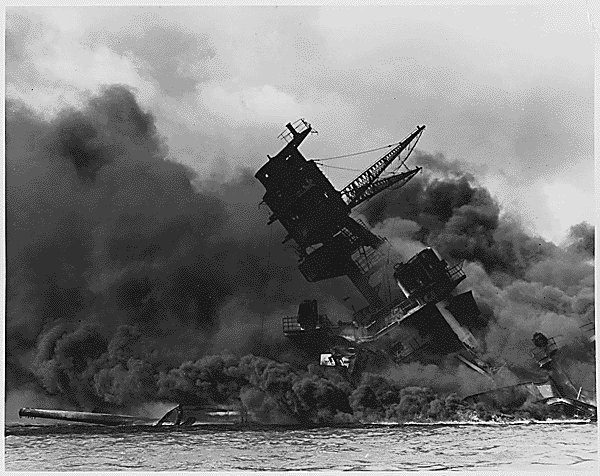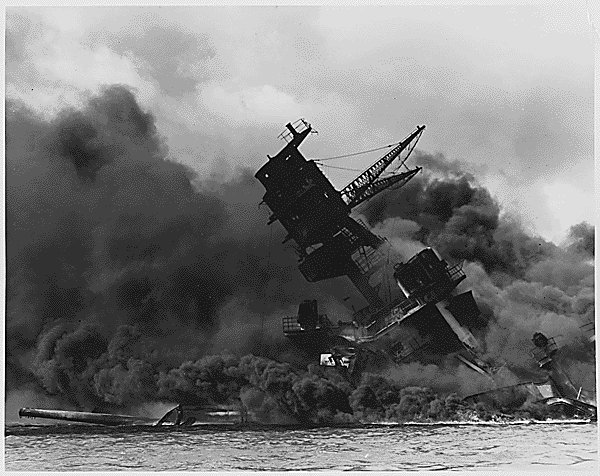
Myths: Fact vs Fiction
Pearl Harbor Attack

August 29, 2008
by Ron Helgemo
Did Churchill know of the impending Japanese attack on Pearl Harbor-but do nothing so as to draw the United States into the war?”Opium for the People”
Mr. Helgemo, whose career includes a spell at the CIA, was president of the Washington Society for Churchill. His article first appeared in Finest Hour 101, Winter 1998-99.
Betrayal at Pearl Harbor: A Television Documentary aired on the History Channel (USA)

2024 International Churchill Conference
On the anniversary of Pearl Harbor, the History Channel, whose programs vary between solid history and opium for the people, ran a BBC-produced documentary claiming that President Roosevelt knew all about the surprise attack and allowed it to happen to get the United States into the war. The program, as Arthur Balfour might have said, contained much that is trite and much that it true, but what was true was trite, and what was not trite was not true.
That “Betrayal at Pearl Harbor” should not be taken seriously is manifestly evident. Examples of why it shouldn’t begin with its interview of Robert Ogg, which approaches dishonesty. The producers fail to inform the audience that Mr. Ogg is the infamous “Seaman Z” immortalized by John Toland, an early conspiracy theorist who wrote that Pearl Harbor was plotted by Franklin Roosevelt.
“Seaman Z,” whose story has had a disconcerting habit of changing over the years, claimed he heard “queer signals” which could have been the missing Japanese aircraft carriers. But he could only have been hearing the carriers if the carriers were broadcasting.
The Japanese themselves claim their fleet (Kido Butai) never sent a single message. They say they dismantled the telegraph sending devices so a message could not be sent. After the war, the Strategic Bombing Survey found the Japanese military’s own after-action report, which credits the success of the attack to the fact that secrecy was maintained.
Among the reasons why secrecy was maintained, radio silence comes first. How could it be, for example, that Seaman Z in San Francisco picked up signals from the Japanese fleet but Hawaii, much closer and lying between California and the fleet, never heard it?
The producers of “Betrayal” also interviewed Eric Nave, a British cryptologist who worked on the Japanese JN-25 naval code. Nave, with the late James Rusbridger, wrote Betrayal at Pearl Harbor, a book claiming Churchill hid what he knew about the attack from Roosevelt. The producers might have mentioned that Nave left Singapore in February 1940, had no further involvement with JN-25, and could not have known of the Japanese change to the JN-25B code in December 1940-and the resulting lack of anyone’s ability to read the code after that date. There are a couple of scenes with Pacific Fleet cryptologist Joe Rochefort, the hero of Midway, who is said to have read JN-25B intercepts. But they fail to mention Rochefort’s claims that he was reading only five to twenty percent of any message in JN-25B prior to Midway and could not have been reading more before then.
The “Winds Code,” which is supposed to have been an attack signal disguised in a Japanese weather report, surfaces again in the History Channel presentation. I have yet to hear an explanation of how the “Winds Code” told anybody anything about Pearl Harbor. Once again Ralph Briggs is dragged out as evidence that the Americans intercepted this message. How Briggs, in Cheltenham, Maryland, heard the coded weather report and no one else did has never been explained; it was supposed to be, after all, a regular mid-day, Japanese time, CB radio broadcast. Nor does the History Channel explain either why the Japanese sent it, since the failure in communications that would have necessitated the “Winds Code” did not occur.
Tucked into the “Betrayal” piece is one Joe Lieb’s claim that Secretary of State Cordell Hull told him of the coming attack and named Pearl Harbor as the target. The trouble here is that Mr. Lieb and Mr. Hull were the only ones present at their alleged conversation, and Mr. Lieb did not see fit to tell anyone of this conversation until after Mr. Hull died. Thus there is no way independently to verify his claim.
An even more preposterous notion presented by the film is that General Marshall (who of course was also in on the plot) went horseback riding on a Sunday morning in order to be “unavailable” for questioners concerned about Japan’s next move, thus assuring the success of the Japanese air raid. Really! “Betrayal at Pearl Harbor’s” case against General Marshall hinges on this, and the fact that he sent an alert warning to Pearl Harbor without sufficient priority. Surely it is easier to consider the latter act one of bureaucratic incompetence rather than a purposeful plot to delay an attack warning? If Pearl was being set up, why send a warning at all? To cover himself? But the warning was kept secret for fifty years!
Geostrategy and codebreaking take up a great deal of the film, which uses them to document accusations of prior knowledge of the coming attack by American authorities. The producers begin by alleging that the United States knew the Japanese attack force was in the Kurile Islands. If it did, then the U.S. had to expect an attack either in Alaska, Hawaii, the west coast or Panama. Of these possible targets, the film says, the only one that made any sense was Hawaii.
But the documentary oversimplifies: having its fleet in the Kuriles did not reduce Japan’s choices of where to attack. Admiral Yamamoto needed to bring the fleet together for an attack in the most secure place possible, regardless of direction. The “southern strategy,” which eventually won out, required the Japanese Navy to neutralize the Philippines (then a U.S. territory), which crossed its sea lanes. This required Yamamoto to go after the U.S. Pacific Fleet at Pearl Harbor. That the Japanese had trouble making up their minds (Japanese Army-Navy politics was at work here too) served them, in the sense that it helped disguise their eventual choice. The “northern strategy” (attacking Alaska) was also seen as a distinct possibility to Westerners. As late as 15 October 1941 Roosevelt wrote Churchill, “I think they [the Japanese] are headed north.” (See Kimball’s Churchill and Roosevelt: The Complete Correspondence.)
Clearly the Japanese had a variety of strategic choices in the months prior to Pearl Harbor. The key to their “Greater East Asian Co-Prosperity Sphere” was China, and that was their major concern throughout. Indeed, while the West may have focused primarily on the Japanese during the Pacific war, the Japanese continued to focus more on China. Even at the war’s end, the Japanese had 1.9 million men and nearly 10,000 aircraft there. It made little sense to Japan to defeat the U.S. if that meant giving up China.
“Betrayal at Pearl Harbor” is very wise after the fact. The imminence of war, it tells us, should have been clear to American planners. Japan’s JN-25B code had been broken. The orders to sail the Japanese Fleet from the Kuriles to a rendezvous point in mid-Pacific were transmitted. The Dutch claimed to have intercepted them, so presumably the British and the Americans should have been able to do the same.
Certainly the imminence of war in the Pacific was obvious to any reasonably intelligent person at the time, but the Pacific did not get thee attention it deserved. To understand why, we must put ourselves in the shoes of leaders at that time-not laboratory analysts of the present. And at that time, the British were up to their eyeballs with Germans and the Americans were fighting an undeclared war with the German Navy in the North Atlantic. Hindsight, of course, is always 20-20. But on whatever the British and Americans “should have been able to do,” let me quote a direct source.
Duane Whitlock, unlike Mr. Nave, was there, on Corregidor, working on the Japanese codes. “I can attest from first-hand experience that as of 1 December 1941 the recovery of JN-25B had not progressed to the point that it was productive of any appreciable intelligence,” stated Whitlock-“not even enough to be pieced together by traffic analysis….It simply was not within the realm of our combined cryptologic capability to produce a usable decrypt at that particular juncture.”
In the early 1990s the U.S. Navy transferred all its cryptologic archives from Crane, Indiana to the National Archives in Washington. This includes 26,581 JN-25 intercepts from 1 September to 7 December. All of these are available for public review. Frederick Parker, who studied 2413 of these intercepts, argues in the film that had they been read at the time, they would have provided clear evidence of the impending attack on Pearl Harbor.
Rusbridger and Nave, in their book, claim they were read, but offer no evidence.
Well, here is the evidence: The 2413 pre-Pearl Harbor intercepts had been decrypted by Navy cryptologists after the war while they were waiting to be mustered out of the service. While Parker makes a strong circumstantial case that the attack would have been discovered had these messages been read, cryptologists at that time would not have been looking just at the 2413 intercepts; they would have been looking at all 26,581. Would they have been able to discern the relevant information from all that noise?
I could go on: the “bomb plot,” the Popov questionnaire, Hull’s “ultimatum” to Japan, etc., all old news, misleadingly presented. Readers may recall that Nave and Rusbridger tried to turn all this around a few years back (just in time to cash in on the 50th anniversary of Pearl Harbor, actually) by claiming it wasn’t Roosevelt after all, it was Winston Churchill who hid the knowledge of the attack in order to draw the United States into the war.
As Professor Warren Kimball wrote: “It seems to me that to brand Churchill and/or Roosevelt as conspirators requires that they be seen as evil geniuses. But for them to allow the U.S. Fleet to be clobbered means they were stupid. That doesn’t compute.”
Allow me to vent for a moment. The reason why this kind of nonsense passes for history is that standards for evidence have virtually disappeared. Not all evidence is equal and there is an obligation to weigh evidence against some reasonable standard. The standard is not exactly rocket science; remnant evidence is better than tradition-creating evidence; corroborated testimony is better than uncorroborated testimony; forensic evidence is better than hearsay.
Our inability to be skeptical, to think critically, to ask questions, to compare and contrast, leads to the perpetuation of one urban legend after another, be it Churchill and Coventry, Churchill and the Lusitania, Churchill (or Roosevelt) and Pearl Harbor, etc., etc., etc. Hard thinking, critical analysis, and skepticism are the only ways to challenge this rubbish. I sometimes despair. Vent off.
Subscribe
WANT MORE?
Get the Churchill Bulletin delivered to your inbox once a month.



